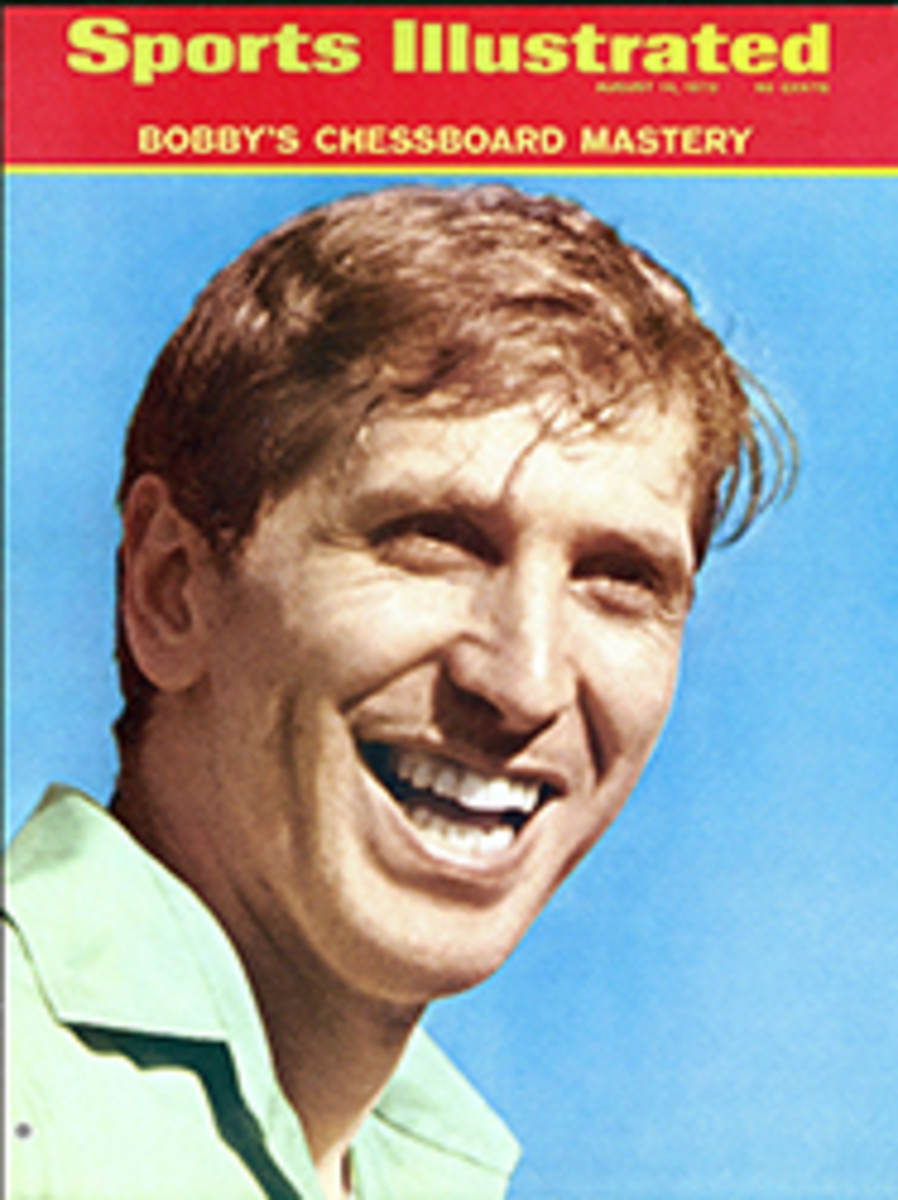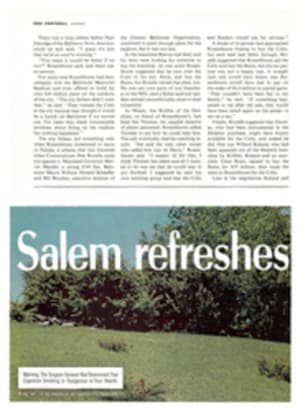
LITTLE JOE MAKES BIG REDS GO
We are really not the mauling type of baseball team that some people think we still are," said Manager Sparky Anderson about his Reds last Saturday night in Cincinnati. "As for those long home runs and huge innings and that ferocious attack we had in 1970, well, it isn't quite the same in 1972. We can still hit home runs, but we don't have to rely on them. We play defense a lot better, and we'll run at you. We try for any opening we can see."
Last week at Riverfront Stadium the new, versatile Reds even managed to run away from the shadow of their own ball park. For most of the season, Cincinnati had not been able to use its stadium to good effect. Then suddenly the Reds, with Pete Rose, Bobby Tolan and Joe Morgan whirling around the bases, began winning even there. Throughout the first three games of a five-game series, Cincy made the Atlanta Braves look as though they were standing for the national anthem. When the speed feast finished, the Reds held a five-game lead in the Western Division of the National League.
Professional baseball has been played in Cincinnati for 104 years, and last Friday evening the Reds reached one million in paid attendance at the earliest date ever. Pennant fever, now more correctly called divisional delirium, was rampant in a city again proud of a team that had played so well in 1970 and so poorly a year ago. The loud boos of spring directed at Catcher Johnny Bench have subsided, proof that 25 home runs and 79 runs batted in in 100 games will still even the angriest of patrons. Contrary to some analyses, however, the Reds of 1972 are not just Bench, Rose, Tony Perez and Gary Nolan. Indeed, the most valuable Red of this season, and perhaps the Most Valuable Player in the National League overall, is Morgan, the 5'7", 150-pound second baseman who can fly on the bases and hit home runs as well.
More than any other man, Morgan has returned the team to the prominence it attained two seasons ago. He currently leads the National League in runs scored and walks and is second to the Cardinals' Lou Brock in stolen bases. He has made only six errors at second base while missing just one of his team's first 100 games. Perhaps most important of all, Little Joe has been on base 43% of the time.
"When you talk about the Big Red Machine this year," says Rose, "you are talking about Joe Morgan and Johnny Bench. Joe has done an unbelievable job for us, both on offense and defense, and he's in scoring position so often that I keep telling Bench that the only time he should not get a run batted in is when he strikes out."
For seven full seasons and parts of two others before joining Cincinnati this year, Morgan both blossomed and wilted in Judge Roy Hofheinz' Houston terrarium. In 1965 he scored 100 runs for a team that lost 97 games, and the following year he was elected the starting All-Star second baseman. Morgan finished that season with a .285 batting average. Two years later he was cut down by a knee injury that allowed him to play in only 10 games. Since then Morgan has stolen 170 bases in 216 attempts. With the Reds, one of Morgan's talents which was frustrated in the Astrodome—the ability to hit home runs—is being given a chance under more natural batting conditions. During his best year with Houston, Joe hit 15 homers. So far this season with the Reds he has already clouted out 13.
The fact that Astro Manager Harry Walker and Morgan did not get along was never truly regarded as news throughout the league. Morgan believes that he was just as good a player in Houston as he is in Cincinnati. "When I was growing up, my two favorite players were Nellie Fox of the White Sox and Ted Williams of the Red Sox," he says. "I liked Fox because he was a second baseman and admired Williams because he knew how to hit and was an expert on the strike zone. I get so many walks because I'm the type of hitter who isn't strong enough to hit bad pitches for base hits. I need to hit strikes. In many ways batting averages can be misleading. There are players in baseball who hit over .300 and don't help their teams as much as other players who hit .250. The idea is to score runs, and that's what I'm supposed to do. A batting average is a personal thing. Unless there are men on base, there is little difference between a single to right field and drawing four balls."
With Rose leading off, Morgan batting second and Tolan third, Cincinnati can put together a first inning attack virtually tailor-made for RBI men Bench and Perez. But the prime reason Cincinnati picked up Morgan was to insure itself against the possibility that Tolan might fail to come back after two Achilles' tendon injuries. If Tolan could not return, the Reds would still need speed, and Morgan was the man who would provide it. "The kind of year Joe is having reminds me of the kind of a season Bobby Tolan had in 1970," a healthy Tolan said the other evening in Houston. "Every time he does something on the bases that leads to a run I say to myself, 'Hey, that was me two years ago.' "
With left-handed hitters Tolan and Morgan in the lineup, the Reds would seem vulnerable to left-handed pitching. Not so. Both are exceptional batters against lefthanders, and the power of Bench and Perez makes managers think long and hard before using lefties. Cincinnati's record against them this year is a lopsided 14-3.
In fact, Cincy seems to encounter more difficulty with its own park than it does from opposing pitchers, righties or lefties. When Riverfront first opened on June 30, 1970, it appeared to be just another saucer-shaped stadium with an artificial surface, but it does have some characteristics which cause it to differ from many other new ball parks. The AstroTurf infield is all rug except for spots cut out on the pitcher's mound, batter's box and the bases. Therefore, a ground ball does not change speeds or bounce erratically as it can in other parks when moving back and forth from either grass or artificial surface to dirt. "I play second base anywhere from 12 to 15 feet deeper here than I do in any other park," Morgan says. "A ball bounces here instead of rolling, and you can play better defense. But your hits have to be hits. There are darn few bad-hop singles."
Were it not for the fact that the Riverfront rug tends to handicap singles hitters such as Rose and Morgan, Cincinnati's record this season would be an enigma. By winning their series from the Braves last week, the Reds finally lifted their home record to .500 for the season, 25-25. The team's road record is 36-14, virtually a complete reverse of the standard process by which pennants are won.
But few things really seem to make sense in the National League West this season. Every team but the Braves has either been in the lead or shared it at one time or another. Los Angeles and Houston were the two most prominent teams during the early going, but uncharacteristic deficiencies arose in each. For years theorists explained that "The Dodgers never beat themselves." They do this year. Consequently the team with the best overall pitching staff in the division found itself last week 9½ games behind the Reds because of shabby fielding. The Glasshouse Gang from Houston was supposed to thrive because needed power had been added to a pitching staff rich in talent and promise. Houston's power has indeed come through; its pitching certainly has not. Youngsters Ken Forsch and Jerry Reuss, who were supposed to lift some of the pressure off experienced starters Larry Dierker, Don Wilson and Dave Roberts, have completed only five of 39 games and compiled a record of 13-13.
In Cincinnati there is still some apprehension about a staff which has yet to pitch two consecutive complete games, but concern about pitching in recent seasons has been as common in Cincy as finding hordes of hippies in Fountain Square. Word last Saturday that number one starter Gary Nolan (13-3) was again having arm problems did not help the morale of Red fans.
But Cincinnati still has Reliever Clay Carroll, The Hawk. In each of the last four seasons Carroll has swooped into over 60 games. So far this year he has made 42 appearances resulting in five wins and 23 saves. "Whenever I walk by him," says Sparky Anderson, "he says, 'The Hawk is sittin' in the tree.' That means that he's ready to fly."
There is still plenty of flying time left before the race is decided, particularly in view of baseball's newest asterisk. Due to the strike at the beginning of the season, teams will finish the schedule with different numbers of games played. The Reds are a 154-game team, Houston will play 153 and the third-place Dodgers 155. If the Reds and Morgan run into any snags, that "all-important" lost column may be as all-important as all get-out to the Astros and Dodgers.
PHOTO
Dashing for another run, Morgan has a leg up on becoming Cincy's most valuable player.

